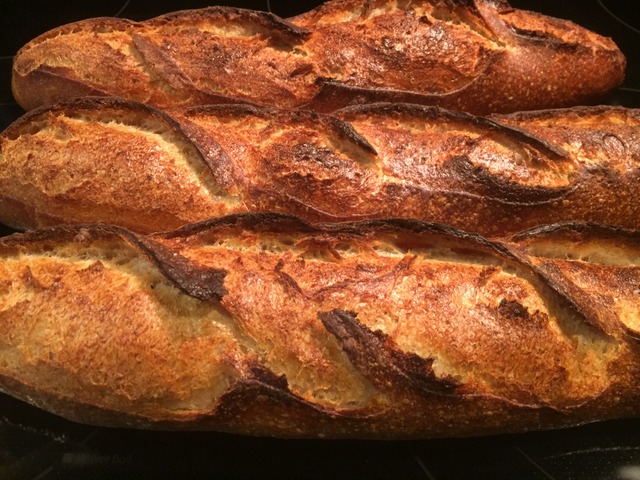A fabulous and incredibly informative set of email exchanges on Mariana’s part a few weeks ago had me:
- Decide to run my own little test.
- Buy the Kindle version of Michel Suas’ Advanced Bread and Pastry @ $45USD
I ran the wonderful and wonderfully reliable Hamelman Vermont SD formula 3 consecutive times over 2 weeks. I’ve baked this enough times, now always using a rye levain vs. his white flour levain. And I'm certain that I can reproduce it with consistency time and again. All activities were the same across the 3 bakes with just one major exception each time.
- 1st bake was hand mixed my standard way – 300 French Folds, generally traditional, until mechanized means were introduced.
- 2nd bake was “mixed” in my 35 year old Kitchen-Aid stand mixer with dough hook.
- 3rd bake was mixed in my 35 year old Cuisinart Food Processor with plastic dough blade.
Having counted RPMs of the stand mixer’s dough hook, the plan was to run on 4th speed at 124 RPM for 5 minutes. A total of 620 turns of the hook. This should approximate a short mix, which was itself pretty much designed to approximate mixing by hand. However, there was some sand in the Vaseline here. The dough repeatedly and almost immediately decided to catch a free ride by climbing the hook, creating a fair amount of invalidity to this comparison. The stopping and starting of the mixer to clear the hook made for a frustrating experience and certainly not worth repeating.
Cusinart phone support stated my food processor model was rated at 1750-1800 RPM – based on “load”. Of which they could not be more specific as to how those RPMs were affected by “load”. I loaded approximately the maximum flour weight recommended. With a relatively low hydration of 65%, I ran the machine for 50 seconds, attempting to get somewhere in the imagined neighborhood of 1000 total revolutions. Or what would fall into the category of an improved mix.
**Late Edit** I neglected to mention that those 50 seconds in the food processor rose the temperature of the dough from ~78-80dF to an unreasonable 87dF. Therefore, I reduced the timing of the bench rise from 120 minutes to 90 minutes with folds at 40 & 80 minutes instead of the standard 50 & 100 minutes. If I were to mix in the food processor from scratch, I'd use iced water to keep the dough temp down.**End Edit**
Because I could not taste the three at the same time, there is no way of discerning whether there were any flavor differences.
1. Hand Mix. These had the most obvious oven spring of the three batches.



2. Stand Mixer. A pretty close match to the hand mixed batch, although I left this about two minutes too long in the oven.



3. Food Processor. Still looked consistent with first two, but I have the notion that the crumb was not quite as open as the others.



Although I gave away the pick of each litter, I warehoused 1 from each of the first 2 bakes. Here are the 3 results side by side. The club-ended baguette was the pure hand mix, and the center baguette was the stand mixer batch.


In summary, I didn’t see a lot of difference, other than mix time among the three mixes, although even with a good oven spring, the food processor batch had what seem to be a more regular crumb with smaller holes.
The stand mixer was a bust and the food processor was a nuisance to clean. Additionally, it takes the sheer joy of hand mixing away from my grubby little mitts. And I like doing that. Cathartic, satisfying, hands in the dough at all times. And easiest to clean up. What’s not to like? Plus, if it gets me a few millimeters closer to whatever the term artisan means this month, then I find that to my liking as well.
Each batch was ~400g x 3 baguettes/long batards